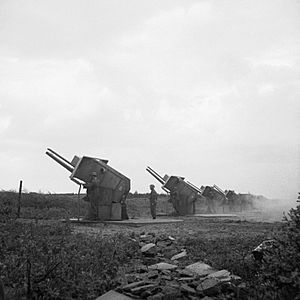Z Battery facts for kids
A Z Battery was a special type of weapon used during World War II in Great Britain. It was designed to protect the country from enemy aircraft. These batteries launched rockets from the ground to shoot down planes. The rockets were about 3 inches (76 mm) wide. Later, these rockets were changed to be used from planes against targets on the ground, becoming known as the RP-3.
How Z Batteries Were Developed

The rockets used by Z Batteries were called UP-3, which stood for "Unrotated Projectile." They were powered by a special solid fuel. These rockets were first developed in the late 1930s by scientists at Fort Halstead in Kent, led by Alwyn Crow.
When World War II began, Winston Churchill, who was then in charge of the Navy, really liked the idea of these rockets. By June 1940, Churchill became the Prime Minister. He asked for many rocket launchers to help defend Britain from air attacks. Professor Frederick Lindemann, who was in charge of rocket development, strongly supported Churchill's plan.
The first rockets were meant to bring down low-flying planes using a long wire with an explosive mine at the end. But for land use, the rockets were designed to explode with a special "proximity fuse" that could sense when they were near an aircraft. A new factory was built in 1940 to make the rocket fuel, and it started production in 1942.
By August 1940, there were over 7,000 rocket launchers ready for use. However, not enough rockets had been made yet. By April, only 18,600 rockets were ready, and the Navy got most of them. This meant only 840 launchers could be used by the army at that time.
In October 1940, a test Z Battery started working in Cardiff, South Wales. It was led by Major Duncan Sandys, who was Churchill's son-in-law. They tested the rockets against a target plane controlled by radio, and the tests seemed successful. Even though some people doubted the results, Churchill and Lindemann pushed the project forward. By 1942, about 2.4 million rockets were being made each year.
Z Batteries in Action
The first Z Batteries used a single rocket launcher called the "Projector, 3-inch, Mark 1." However, it was soon discovered that the rockets were not as accurate as expected, and their special fuses often didn't work well. To fix this, they started firing many rockets at once, in a "salvo."
New launchers were developed that could fire more rockets at a time. The "Projector, 3-inch, No 2, Mk 1" could fire two rockets. Even bigger launchers, like the "No 4 Mk 1 and Mk 2," could fire a ripple of 36 rockets!
During the Battle of Britain, a German bomber called a Dornier Do 17 attacked RAF Kenley. A soldier named AC2 David Roberts used the newest anti-aircraft weapon, which was a line of 25 rockets. These rockets deployed a wall of cables suspended by parachutes, about 500 feet (150 meters) high. This weapon, a naval version of the Z Battery, helped bring down one of the two attacking planes. The other Dornier 17 was shot down by Corporal John Miller using a Lewis gun. Both men were awarded the Military Medal for their bravery.
From early 1942, the Home Guard started taking over the Z Batteries. This was because the equipment was quite simple to use, and the rockets were lighter than traditional anti-aircraft shells. This allowed regular soldiers to be sent to other important fighting areas. Home Guard members up to 60 years old could work on Z Batteries, while those on heavier guns had to be younger.
Rockets for Ground Attacks
The No 2 and No 4 rocket launchers were also used in the North African Campaign. They were mounted on converted gun trailers. In one emergency, a No 4 launcher was used against enemy soldiers on the ground. This inspired the creation of the "No 8 Projector," better known as the Land Mattress. This was a rocket system used by the Canadian Army in 1945 to attack targets on the ground. The UP-3 rocket was also developed into the RP-3, an anti-tank rocket launched from aircraft.
See also
- AA Mine Discharger, a Japanese anti-aircraft mortar.
- Holman Projector, a steam-powered anti-aircraft grenade launcher.
- Henschel Hs 297 / 7.3 cm Föhn-Gerät, a German anti-aircraft rocket system.
- Bethnal Green disaster



